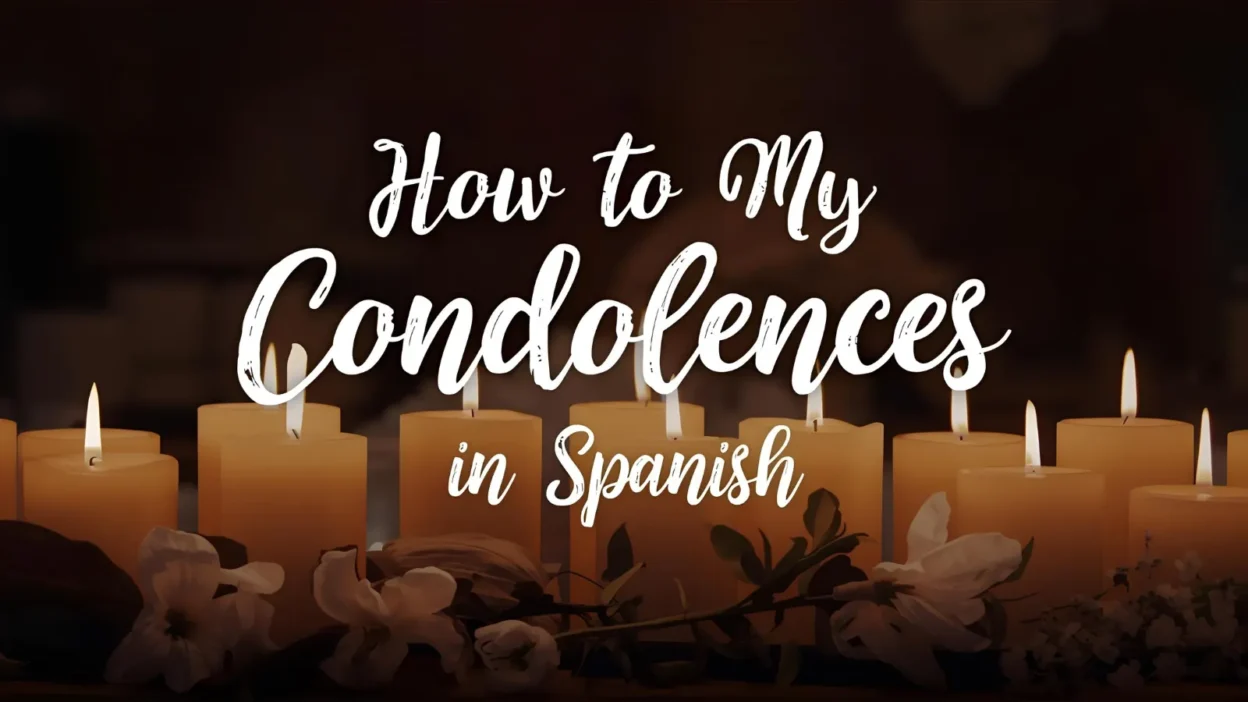Learning how to say my condolences in Spanish is an important way to express sympathy and support during difficult times. In Spanish, offering condolences shows respect, kindness, and understanding toward someone who is grieving.
Whether it’s for a friend, coworker, or family member, knowing the right words helps you speak from the heart and show compassion in a sincere way.
It also helps you connect more deeply with Spanish speakers on an emotional level. Even simple phrases can bring comfort and show that you truly care.
Say My Condolences in Spanish
1. Mis condolencias – “My condolences”

Origin: From Latin condolēre, meaning “to suffer together.”
Example:
👤 Mis condolencias por tu pérdida.
Use: The most standard and formal way to express sympathy in Spanish.
2. Lo siento mucho – “I’m very sorry”
Origin: From sentir (to feel); literally “I feel it a lot.”
Example:
👤 Lo siento mucho por lo sucedido.
Use: Common and sincere; works in both personal and formal situations.
3. Te acompaño en el sentimiento – “I share your pain”

Origin: Traditional Spanish condolence phrase meaning “I accompany you in your feelings.”
Example:
👤 Te acompaño en el sentimiento, amigo.
Use: Very respectful; common in Spain and Latin America.
4. Mis más sinceras condolencias – “My most sincere condolences”
Origin: Formal variation of mis condolencias.
Example:
👤 Mis más sinceras condolencias a ti y tu familia.
Use: Polite and emotional; often used in cards and messages.
5. Lamento mucho tu pérdida – “I deeply regret your loss”
Origin: From lamentar (to mourn or regret).
Example:
👤 Lamento mucho tu pérdida, hermano.
Use: Gentle and heartfelt; suitable for close friends.
6. Que en paz descanse – “May they rest in peace”

Origin: Common religious phrase used in Catholic traditions.
Example:
👤 Que en paz descanse tu abuela.
Use: Often used when referring directly to the deceased.
7. Mis pensamientos están contigo – “My thoughts are with you”
Origin: Translated from English condolence messages.
Example:
👤 Mis pensamientos están contigo en este momento difícil.
Use: Soft and caring; ideal for sympathy notes.
8. Estoy aquí para ti – “I’m here for you”
Origin: Expresses emotional support rather than formal condolences.
Example:
👤 Estoy aquí para ti si necesitas hablar.
Use: Personal and comforting; great for friends or loved ones.
9. Te envío un fuerte abrazo – “Sending you a big hug”
Origin: Cultural gesture of emotional warmth and comfort.
Example:
👤 Te envío un fuerte abrazo en estos momentos difíciles.
Use: Warm, informal, and very common among Spanish speakers.
10. Mi corazón está contigo – “My heart is with you”
Origin: Romantic and empathetic phrase.
Example:
👤 Mi corazón está contigo durante esta pérdida.
Use: Deeply emotional; used with close friends or family.
11. Mis oraciones están contigo – “My prayers are with you”

Origin: Religious expression offering spiritual comfort.
Example:
👤 Mis oraciones están contigo y tu familia.
Use: Common among religious speakers, especially Catholics.
12. Que Dios te dé consuelo – “May God give you comfort”
Origin: Faith-based condolence wish.
Example:
👤 Que Dios te dé consuelo en este momento tan duro.
Use: Used by believers to show empathy and faith.
13. Te mando mi apoyo – “I send you my support”
Origin: Derived from apoyar (to support).
Example:
👤 Te mando mi apoyo y fuerza.
Use: Simple and genuine; fits casual or formal tone.
14. Fuerza en estos momentos – “Strength in these times”
Origin: Modern phrase used in texts and social media.
Example:
👤 Fuerza en estos momentos, amigo.
Use: Encouraging and empathetic; informal but comforting.
15. Estoy contigo en este dolor – “I’m with you in this pain”
Origin: Emotional and heartfelt condolence expression.
Example:
👤 Estoy contigo en este dolor tan grande.
Use: Deeply personal and compassionate.
❓ FAQs
Q1: What is the most common way to say “my condolences” in Spanish?
A: The most common phrase is mis condolencias.
Q2: How do you say “I’m sorry for your loss” in Spanish?
A: You can say lo siento mucho por tu pérdida or lamento tu pérdida.
Q3: How do you offer condolences formally in Spanish?
A: Use mis más sinceras condolencias or te acompaño en el sentimiento.
Q4: How do religious people express sympathy in Spanish?
A: Common phrases include que en paz descanse and que Dios te dé consuelo.
Conclusion:
Knowing how to say my condolences in Spanish helps you show genuine care and respect when someone is going through loss. Using heartfelt phrases not only expresses sympathy but also builds emotional connection and comfort. Whether spoken or written, these words remind others that they’re not alone in their grief. A small gesture of kindness in their language can mean more than you realize.



